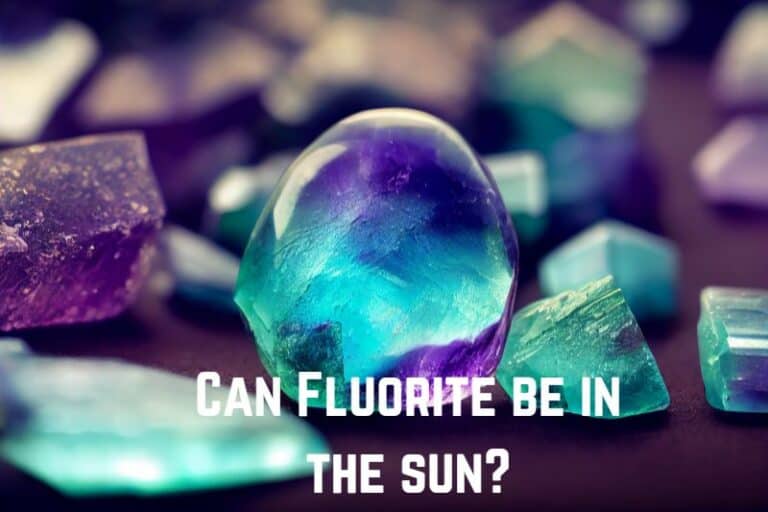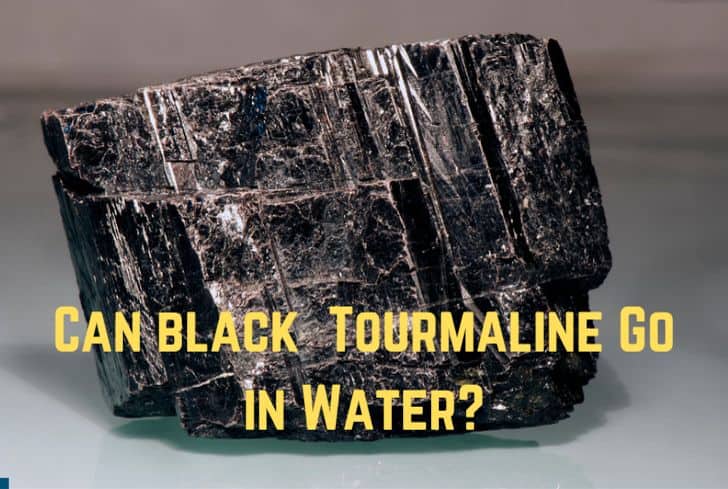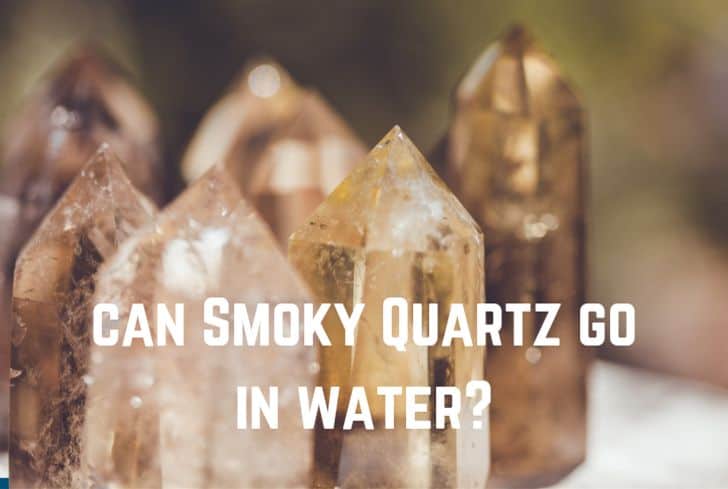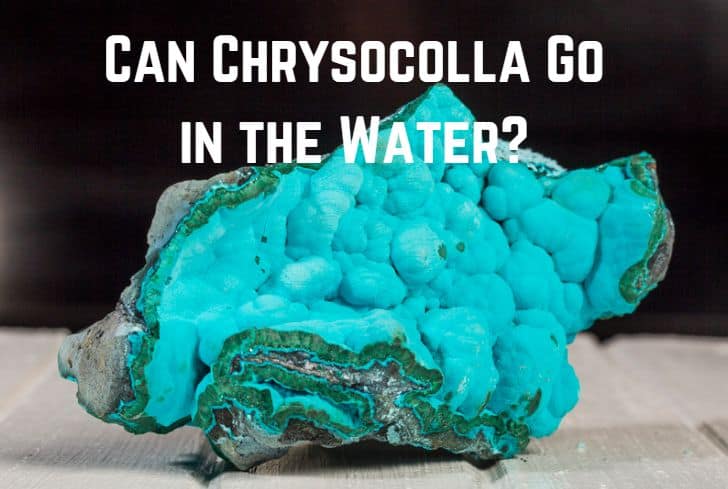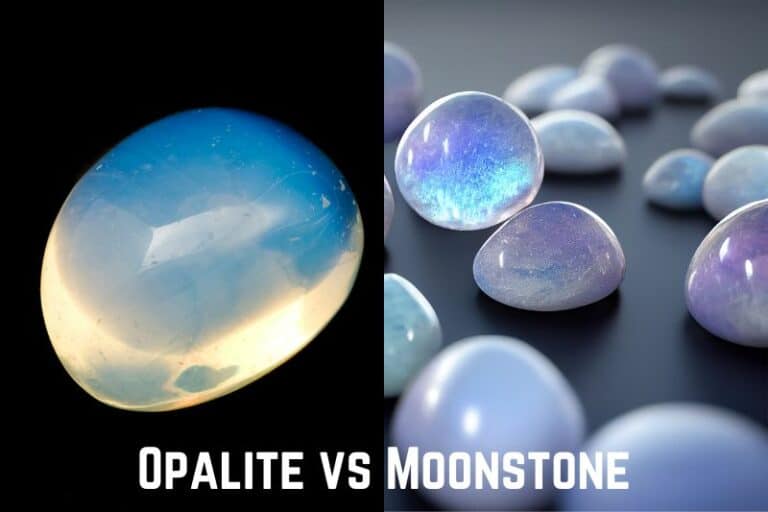Can Angelite go in the Water? (And in Sunlight?)
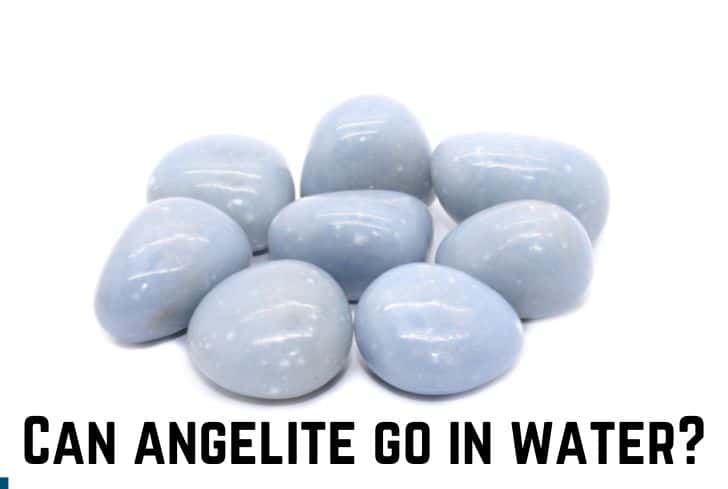
Angelite is a kind of anhydrite or anhydrous calcium sulfate (CaSO4). It is a semi-transparent bluish-grey mineral that was first discovered in Peru during the late 20th century. The mineral’s name comes from the term “anhydrous”, meaning “without water”, referring to the fact that anhydrite is gypsum without water.
In this article, we are going to discuss whether you can put Angelite in water or not. We will talk about its formation and properties. Then we will see how Angelite interacts with sunlight and salt. Finally, we will learn about checking the authenticity of Angelite and how to take care of it.
Can Angelite Crystal go in the Water?
No, Angelite can not be put into water. Its value on the Mohs Hardness Scale is 3.5, which is below the minimum value required for minerals to survive underwater. If Angelite comes into contact with water, the crystal will get damaged. More specifically, the anhydrite will transform into gypsum.
Mohs Hardness Scale is a measure of the relative resistance of a mineral to scratching. It also gives an indication of the mineral’s relationship with water, a value of 5 being the lowest required for a mineral to survive immersion. Since Angelite’s hardness is 3.5, it will get damaged in water.
Angelite is a variety of anhydrite or anhydrous calcium sulfate. When this mineral is exposed to water, it transforms into gypsum or calcium sulfate dihydrate (CaSO4·2H2O). This is why you must not immerse your Angelite crystal in water.
If you have Angelite jewelry, do not wear it during bathing or swimming.
Can Angelite go in Sunlight?
Yes, Angelite can go in sunlight. However, it should not be kept out for too long or too often as excessive sunlight can fade the stone’s color and tarnish its surface. While keeping your stone out, also ensure that it is not kept on a surface that can come into contact with water, as that will damage the Angelite.
Many people put their stones out in the sun to recharge them. You can keep your Angelite stone under sunlight for about 30 minutes. To make things safer, you can also put it behind a window, and the glass will act like a protective shield. You can also try putting the stone out during morning hours when sunlight is gentle.
If you are not too keen on putting your stone out in the sun, you can also try other recharging methods, such as keeping it in the moonlight. However, you should not bury it in mud, as the moisture will ruin the stone.
Can Angelite go in Salt?
It’s not recommended to put Angelite into salt. Angelite is not a very hard mineral, having a value of 3.5 on the Mohs scale. If salt crystals rub against its surface, they have the potential of damaging it. While salt can do minor damage to your Angelite, saltwater will ruin it completely—Angelite should never be exposed to water.
Placing a stone in a bed of dry salt is a standard method of recharging. But it’s not recommended for soft minerals like Angelite. Instead, you can try keeping your Angelite stones out in sunlight or moonlight.
How is Angelite Formed?
Angelite is an evaporite, meaning that its crystals are formed by evaporation from an aqueous solution. They are found in areas where gypsum stones have been exposed to water; when the water evaporates, we get Angelite as the remaining crystals.
The presence of sodium or potassium chloride, along with a temperature above 104° F (40° C), causes the aqueous solution of calcium sulfate to leave anhydrite deposits. Once scientists understood this, they were able to prepare the mineral artificially.
This lab-created version of Angelite is the same as the natural one, which is usually found in salt basins. Besides that, Angelite is also found in the following sources:
- Anhydrite occurs in the nodular form in tidal flats, such as that of the Persian Gulf sabkha. These have a unique net-like appearance and are often called chicken-wire anhydrite.
- It also occurs in caprocks formed by salt domes. When halite is removed by water pores, Angelite is left as a cap at the top of the salt.
- Finally, they are also found in igneous rocks, such as the pumice erupted by the El Chichón volcano in Mexico.
Anhydrite is used as a drying agent in plasters, cement, and paint. It is also combined with gypsum to create plaster and wallboards. Anhydrite is also used in the production of sulphuric acid.

Physical Properties of Angelite
Angelite is a variant of anhydrite or anhydrous calcium sulfate. Its properties are:
- Hardness: Angelite is a soft mineral that has a value of 3.5 on the Mohs Hardness Scale. Since this is below the threshold value of 5, Angelite cannot be put into water. Moreover, given its softness, Angelite has to be cautiously used around other minerals because they can scratch it.
- Structure: Angelite has the orthorhombic crystal system, meaning that it has three perpendicular axes that are unequal in length. It exhibits three directions of perfect cleavage that are parallel to the planes of symmetry. Angelite usually occurs in the form of cleavage masses, and well-defined crystals are rare.
- Appearance: Angelite comes in blue, white, and grey colours. The streak color, that is, the color of the mineral in its powdered form, is usually white. The mineral shows a pearly lustre, and it can either be transparent or translucent.
- Relationship with Gypsum: Angelite is a variant of anhydrous calcium sulfate (CaSO4). When Angelite is exposed to water, it transforms into the more common mineral, gypsum. What’s interesting is that this transformation can be reversed by heating gypsum to 400°F (200°C)
- Associations: Angelite usually occurs along with calcite, halite, gypsum and limestone in vein deposits. These minerals are often confused with each other because of their similar properties.
Besides the physical properties, Angelite is also said to have healing properties, which is rather apparent from its common names like “Angel Stone” or the “Gateway Crystal”. Many believe that it brings about a peaceful energy that is calming. It is closely associated with the astrological sign of Aquarius, and due to its blue color, related to the throat, third eye and crown chakras.
How do You Care for Angelite?
Angelite is a soft mineral. Given its hardness of 3.5 on the Mohs scale, its stones are prone to get damaged by water and also other harder stones. Therefore it is important to be very cautious in its care. It should never be immersed in water for cleaning.
If you are wearing Angelite jewelry, make sure you take it off during activities like swimming or showering, as the water can damage the Angelite. You also need to keep it separate from harder stones, so that its surface is not scratched. Sharp blows and temperature changes can also damage the stone, so try avoiding those too.
To clean your Angelite stone, all you need is a soft, dry cloth. For recharging it, you can leave it out for a short time in sunlight or moonlight. Do not bury it in mud as the groundwater can damage it.
How Can You Tell if Angelite is Real?
To check the authenticity of a stone, you need to learn about its actual characteristics. For Angelite, here are a few features you can look for to see if it is real:
- Texture: In its raw form, Angelite will feel rough to touch, almost chalky.
- Hardness: Angelite is a soft mineral and will easily get scratched with a needle.
- Location: This mineral is mostly found in Peru, the UK, and Germany.
- Appearance: Angelite is usually blue, grey, or white with flecks. The stone doesn’t exhibit a prominent glimmer effect but it does have a pearly lustre.
- Weight: A 1.5-inch Angelite stone can weigh over 22 grams, and its heaviness is a good indication of its authenticity.
If you find that any of these properties are amiss, you might be dealing with something other than Angelite.
Angelite’s cubic cleavage is the most distinctive property, and it will help you identify the stone. With a hand lens, you can even check this in a fine-grained specimen: the stone will have perfect cleavage in three directions, forming cubic-shaped fragments.
Angelite is also often confused with other minerals like halite, gypsum, or calcite. But there are ways to distinguish them. Unlike gypsum, Angelite has cubic cleavage and is also harder. Angelite’s right-angled cleavage and lack of acid reaction help to differentiate it from calcite. Finally, unlike halite, Angelite is not soluble and is also slightly harder.
Check out this video by ColdBrewBarbie to find out how to differentiate between Angelite, celestite, and blue calcite.
Conclusion
In this article, we have discussed Angelite’s reaction to water. As a soft mineral having a value of 3.5 on the Mohs Hardness scale, Angelite should not be put into water. We looked at the properties of Angelite and saw how it transformed into gypsum upon being exposed to water. Finally, we discussed how to take care of Angelite and verify its authenticity.

